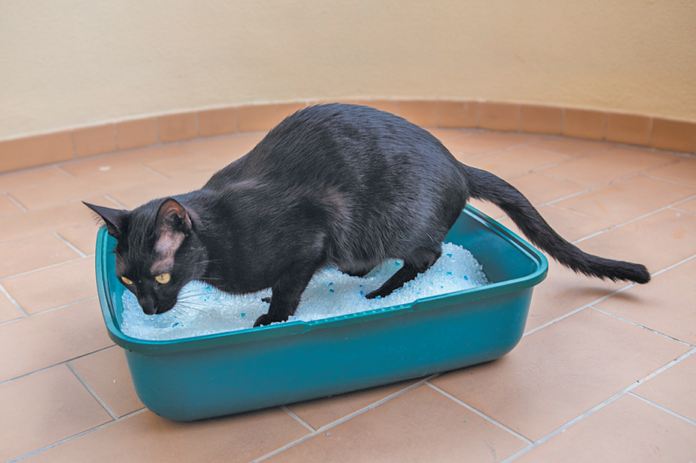You know that if your cat starts eating less or keeping to herself more, something might be amiss and you should schedule a doctor’s visit. But there are other signals that your pet may well be in the throes of a life-or-death emergency and needs to see the veterinarian now. Here’s a rundown.
Straining to urinate. If a female cat keeps making unproductive trips to the litter box — trying to urinate but only dribbling a few drops — you’re not racing against time. But you should still get her to the vet’s office ASAP because she probably has a bladder inflammation, which can prove extremely uncomfortable and needs relief with appropriate treatment depending on what’s causing the problem.
When a male cat strains to urinate, on the other hand, it is potentially a life-and-death situation. If it’s not a bladder inflammation, it may be a urinary blockage (extremely rare in females). Don’t guess — just take your cat right in. A urinary blockage that’s not tended to right away can very quickly result in kidney damage, metabolic imbalances, and even death.
Labored breathing. Plenty of cats suffer upper respiratory infections. Just like us, they get stuffy noses and plugged sinuses and may make unusual noises when they’re sleeping. They should be seen by a veterinarian, but you don’t have to put down what you’re doing and scoop up your pet to get to the doctor’s office immediately.
A cat exhibiting labored breathing, however, requires immediate attention. This is especially so if he’s struggling for air while at rest. He should not be gasping for breath as if he just ran around the block several times when all he has been doing is lying around and engaging in his usual routine.
It’s also not normal for a cat to breathe with his mouth open. If that’s going on, get him to the nearest emergency clinic immediately, even if you have to find one that’s open in the middle of the night. It could signal pulmonary edema (fluid in the lungs) or pleural effusion (fluid between the lungs and the chest wall). Fluid stops the lungs from expanding fully, and it needs to be treated so the cat can breathe freely.
Persistent vomiting. A single episode of vomiting or retching — or even two — shouldn’t alarm you. But a cat who can’t stop vomiting, or trying to vomit, should be taken in. It could be a sign of something wrong in the gastrointestinal tract, a food allergy, or even kidney disease. Sometimes it signals an obstruction caused by swallowing something he shouldn’t have. Food can’t get through, so he keeps sending it back up — or trying to.
Seizures. If your cat has diabetes and suffers a seizure, try rubbing some honey onto his gums. It might return him to a relatively normal state. But he, along with any other cat who has a seizure, should be taken to a veterinarian’s office immediately. Seizures can be caused by such disparate things as liver disease, or the neurologic disorder epilepsy. Whatever the trigger for the seizure, it has to be identified and treated right away in order not to cause further damage.
Staggering/Stumbling. This isn’t about an accident resulting from a fall or getting hit by something, although of course those things may very well require an immediate trip to the emergency room. It’s about problems that cause staggering that have nothing to do with physical impediments. For instance, metabolic issues including excessively low potassium, low blood sugar, or anemia could cause a cat to start wobbling. So could a middle ear infection, which causes difficulties with balance.
There are reasons a cat may stumble temporarily that are not serious. But there’s no way for an owner to be able to make a diagnosis. For safety’s sake, if you see your cat staggering, get him to the doctor right away. Something very serious might be going on.
Bleeding. Of course if your cat has a wound causing bleeding that you can’t stop with gentle pressure — and particularly if the blood is pulsating from the body in little bursts rather than just dribbling out without any “thrust” — you need to get your cat to the emergency room without delay. But you should also take him to the vet if you notice blood in his urine or stools, or if you see little spots of blood on furniture or bedding. Blood in the urine can signal a painful bladder stone. And blood in the stools can be indicative of a problem in the GI tract or elsewhere.
Non weight-bearing lameness. A cat might limp for a day or two here and there, especially as he gets older and his body becomes less resilient. Perhaps he has pulled a muscle, strained a tendon, or has to deal with arthritis that acts up intermittently. But if more time goes by, he should be evaluated by a vet.
Ditto for a cat who cannot bear any weight on one or more limbs. Such non weight-bearing lameness can be a sign of a bone break, dislocation, or a torn ligament. The sooner painful injuries like these are addressed, the better the chance for proper healing and resistance to further injury down the line.




